
| Walk 2 - Cape Kidnappers |
I would have thought that after walking 630 km along the south coast of New South Wales, we would be tired of coastal landscapes, but it seems that we are drawn to them. However, the 17.5 km return walk from Clifton to Cape Kidnappers on the southern rim of Hawkes Bay is a cliff walk with a difference. Most cliff walks that we have done to date pass mainly along the tops of the cliffs, but this walk is spent entirely at the base of the impressive cliff line in the narrow zone between high and low tide. In fact the walk can only be done safely 3 hours either side of low tide. We set out 3 hours precisely after high tide and almost immediately found ourselves on a grey pebble covered beach at the base of the 140 m high cliffs; their size more impressive from below than from above. It was a cool morning, and the overcast sky created a moodiness that seemed to suit the location, the cliffs keeping the cold southerly wind at bay and adding a stillness that enhanced this moody ambience. |
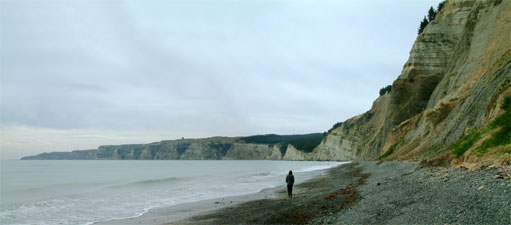 The sweeping curve of the 6 km cliff line between Clifton and Black Reef |
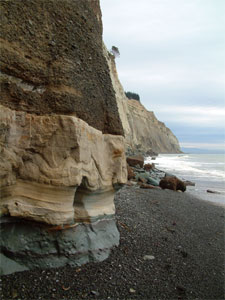 Sedimentary layering in the cliff face |
The cliffs illustrate some of the different geological influences on New Zealand landforms, with different sedimentary layers comprising siltstone, sandstone, volcanic ash, conglomerates and even narrow bands of marine fossils. Tilting and slipping of the rock strata gave the cliff line a jagged saw tooth appearance and we passed several deep side gorges, with varying degrees of vegetation, that had formed in the cliff line where the fault lines had been further eroded by water flowing off the plateau above.
|
 A pair of feral goats scrambling up the face of a side gorge |
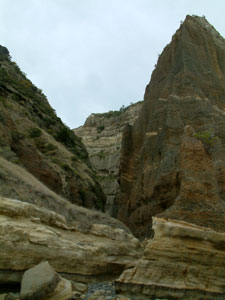 One of several deep side gorges dissecting the cliff line |
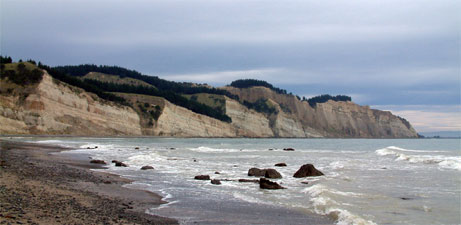 Tilting and slipping of rock strata in the cliffs |
 Looking back along the cliff line from Black Reef |
|
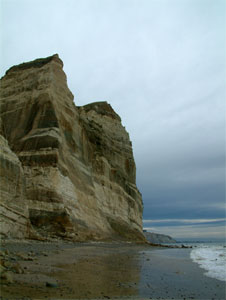 140 m pillars near Black Reef |
|
|
|
|
|
|
|
|
|
|
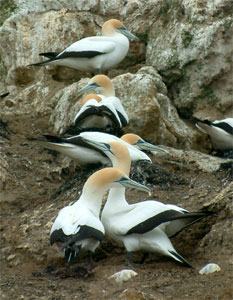 |
|
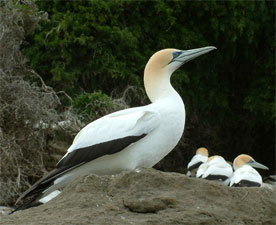 |
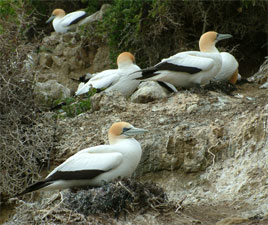 |
|
Leaving the gannets, we turned south towards Cape Kidnappers, with its sheer siltstone cliffline. On our right, the cliffs had been replaced by pasture covered slopes from which a few sheep watched our passage. We ended the outward section of our walk with lunch at the gannet reserve shelter as access to the main Cape nesting colonies was closed. After the end of October, these are open to the public and the walk could be extended by a climb up to the top of Cape Kidnappers - however, you then have to share the beach with tractors pulling wagon loads of tourists to see the birds. Up to you, but we think it would be better when the beach is a peaceful place and you can still enjoy the full gannet experience at Black Reef. Although we normally don't like returning along the same track, the walk back from Cape Kidnappers to Clifton was very different, with views directed more to the land and mountain ranges across Hawkes Bay, as opposed to a more oceanic focus on the walk out. To look out at snow-covered ranges across the broad expanse of Hawkes Bay was something special. If you like cliffs and sea birds, Cape Kidnappers is a top coastal walk. |
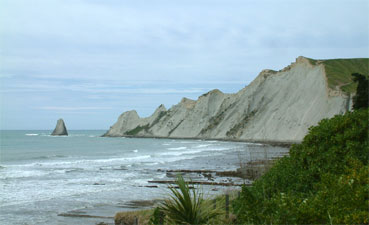 The smooth siltstone cliffs of Cape Kidnappers |
 |